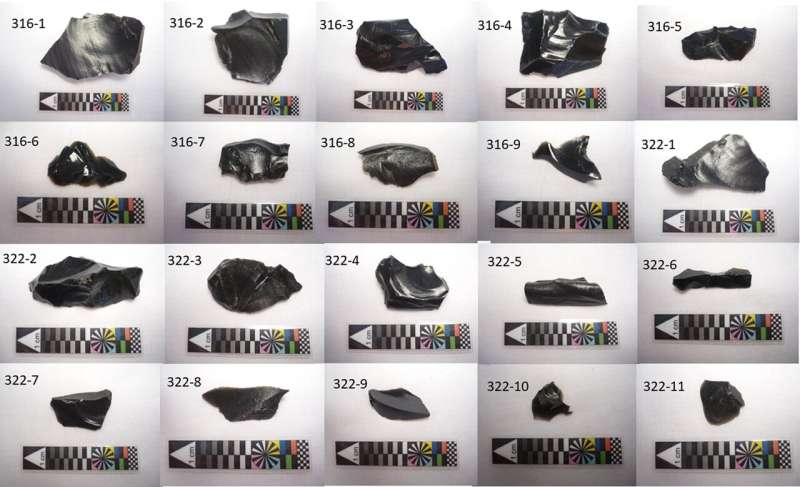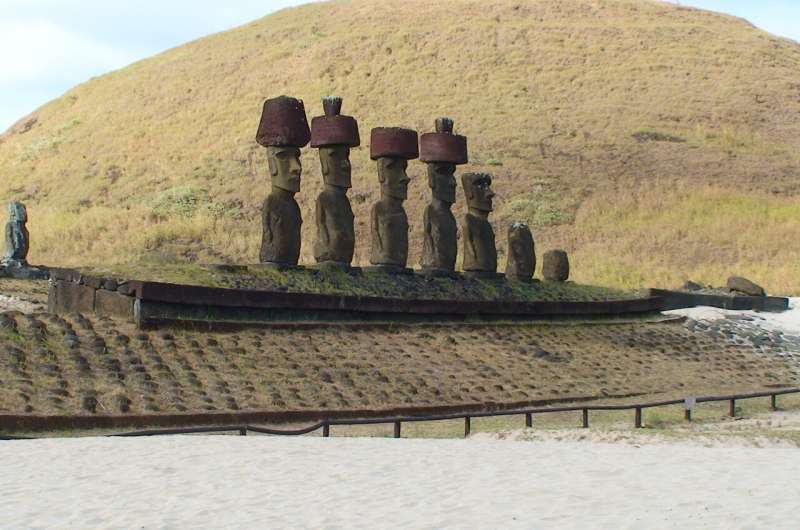Plant material on obsidian blades on Rapa Nui suggests settlers there visited South America and returned
A team of archaeologists affiliated with several institutions in Chile reports evidence that early settlers on the island of Rapa Nui sailed to South America, interacted with people living there and then returned. In their study, published in PLOS ONE, the group analyzed plant material found on obsidian blades made by the early settlers.
Prior research has shown that there were people living on Rapa Nui during the years 1000 to 1300, though their origin is still not known—those early settlers are most famous for their giant stone carvings of human figures.
In this new study, the research team found evidence that some of the settlers sailed all the way to the coast of South America and back. Such a voyage would have entailed sailing one way for 3,700 kilometers and likely would have taken anywhere from one to two months, depending on the weather.
Prior research has found that the oral history of the Rapu Nui people includes reports of at least one trip made by the early settlers to South America. In this new effort, the research team followed up on such reports by digging up and studying obsidian blades at a site called Anakena, the earliest known settlement on the island. The researchers found very small amounts of plant material on the blades, evidence that they were used to process plant-based food.

An analysis of the plant material showed evidence of cassava, breadfruit, purple yam, taro, achira, ginger and the Tahitian apple. Of those, the Tahitian apple and breadfruit stood out because neither grows naturally on Rapa Nui—and ginger had never been seen before in remote parts of Oceania.
Cassava, sweet potato and achira stood out for a different reason—all three are South American foods. They also noted that the sweet potato remnants were found in the deepest parts of the dig site, suggesting that they arrived on the island during the early years of the settlement.
The researchers conclude that early Rapu Nui settlers ventured to South America and back, perhaps several times. They further suggest that some of the food they brought back with them was planted and used to grow crops over the ensuing years.
More information:
Paloma Berenguer et al, Identification of breadfruit (Artocarpus altilis) and South American crops introduced during early settlement of Rapa Nui (Easter Island), as revealed through starch analysis, PLOS ONE (2024). DOI: 10.1371/journal.pone.0298896
© 2024 Science X Network
Citation:
Plant material on obsidian blades on Rapa Nui suggests settlers there visited South America and returned (2024, March 21)
retrieved 21 March 2024
from https://phys.org/news/2024-03-material-obsidian-blades-rapa-nui.html
This document is subject to copyright. Apart from any fair dealing for the purpose of private study or research, no
part may be reproduced without the written permission. The content is provided for information purposes only.

A team of archaeologists affiliated with several institutions in Chile reports evidence that early settlers on the island of Rapa Nui sailed to South America, interacted with people living there and then returned. In their study, published in PLOS ONE, the group analyzed plant material found on obsidian blades made by the early settlers.
Prior research has shown that there were people living on Rapa Nui during the years 1000 to 1300, though their origin is still not known—those early settlers are most famous for their giant stone carvings of human figures.
In this new study, the research team found evidence that some of the settlers sailed all the way to the coast of South America and back. Such a voyage would have entailed sailing one way for 3,700 kilometers and likely would have taken anywhere from one to two months, depending on the weather.
Prior research has found that the oral history of the Rapu Nui people includes reports of at least one trip made by the early settlers to South America. In this new effort, the research team followed up on such reports by digging up and studying obsidian blades at a site called Anakena, the earliest known settlement on the island. The researchers found very small amounts of plant material on the blades, evidence that they were used to process plant-based food.

An analysis of the plant material showed evidence of cassava, breadfruit, purple yam, taro, achira, ginger and the Tahitian apple. Of those, the Tahitian apple and breadfruit stood out because neither grows naturally on Rapa Nui—and ginger had never been seen before in remote parts of Oceania.
Cassava, sweet potato and achira stood out for a different reason—all three are South American foods. They also noted that the sweet potato remnants were found in the deepest parts of the dig site, suggesting that they arrived on the island during the early years of the settlement.
The researchers conclude that early Rapu Nui settlers ventured to South America and back, perhaps several times. They further suggest that some of the food they brought back with them was planted and used to grow crops over the ensuing years.
More information:
Paloma Berenguer et al, Identification of breadfruit (Artocarpus altilis) and South American crops introduced during early settlement of Rapa Nui (Easter Island), as revealed through starch analysis, PLOS ONE (2024). DOI: 10.1371/journal.pone.0298896
© 2024 Science X Network
Citation:
Plant material on obsidian blades on Rapa Nui suggests settlers there visited South America and returned (2024, March 21)
retrieved 21 March 2024
from https://phys.org/news/2024-03-material-obsidian-blades-rapa-nui.html
This document is subject to copyright. Apart from any fair dealing for the purpose of private study or research, no
part may be reproduced without the written permission. The content is provided for information purposes only.
